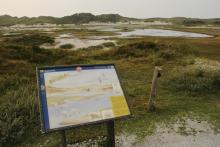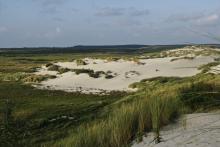
This case study is about enhancing the natural dynamics of the dunes and the sand transport on the Wadden Sea island of Terschelling, Netherland
Based on the WWF study "Klimaanpassung an weichen Küsten - Fallbeispiele aus Europa und den USA für das schleswig-holsteinische Wattenmeer"
Terschelling is one of the West Frisian Wadden Sea islands and feature one of the largest dune areas in the Netherlands. The dunes have been dynamically evolved by deflation, wandering dunes and periodic flooding leading to valuable ecosystems with the characteristic of rejuvenating dunes. These natural processes have been disrupted in the past by planting or measures with the aim of fixing the coastline. With the introduction of drainage systems at Terschelling the groundwater level has been lowered and wetlands in the dune system are declining. Simultaneously, by limiting the sediment transport from the beach to the dunes and the plant covering of the dunes, the dunes are aging. Overall, natural dynamics at the dunes were hindered and because of the limiting of the sediment transport, the adaptive capacity to sea level rise (and resulting higher floods) are also limited.
Therefore, a solution was sought to enable a more natural and dynamic development of the dune system at Terschelling.
Technical feasibility
In 1994, on a 5 km stretch of the northern coast line of Terschelling, the outer dunes were mechanically opened to start a rejuvenation process of the dune system. With the help of reed fences along these cuts, wind regimes were channeled so over the years a considerable amount of sand was blown from the beach through the dunes into the inland.
Additionally an artificial wetland was created (called ‘Eldorado’) by the removal of pine forest and other vegetation. This has rejuvenated the dune and to keep the vegetation limited, grazing is undertaken. This additional project was carried out by the dutch public organization Staatsbosbeheer (http://www.staatsbosbeheer.nl/english) as part of a LIFE project called ‘Saving the Dutch dunes’(LIFE05 NAT/NL/000124). It is important to note that the approach of the dynamic dune management has no negative impact on the safety of the people of Terschelling during storm floods. The natural sand transport from the beach has the effect that the dune system is ‘growing’ with the sea level rise.
Political & social feasibility
Initially, there was skepticism among the inhabitants of the island towards this measure. Especially lowering the outer dunes so that the ocean was visible from the inner dunes worried the inhabitants. It was also criticized that grassland that was turned to arable land in former times, should again be covered by sand. These issues could partly be explained by insufficient communication between all stakeholders.
For tourism, a main economic sector of Terschelling, this a beneficial approach, since 90% if visitors stated in a local survey being fond of the ‘living dunes’.
Ecological feasibility
Without further intervention new dunes have formed through sand drift. Especially for Natura 2000 habitats such as primary and white dunes this can be seen as very positive. Goats will help to keep the dune areas open, so the valuable habitats will be preserved.
Instead of stabilizing the dunes consistently by planting vegetation and other measures, aim was to allow dynamic coastal processes with a stable safety standard. An important part of this new management approach was the improvement of the natural sand transport from the beach to the dunes.
The example of Terschelling showed that a more natural sand transport from the beach over the dunes to the hinterland was actually possible. Habitats such as primary and White dune re-emerged or developed closer to nature, additional sand deposits accumulated in the dunes and serve as long-term adaptation to sea level rise. However, this more local effect will not solve the ‘sand-deficit’ on outer coasts, therefore additional sand deposits (for example beach nourishment) may be required. Overall, this example shows that a restoration of natural processes can contribute to a long term security of the island and their inhabitants.











